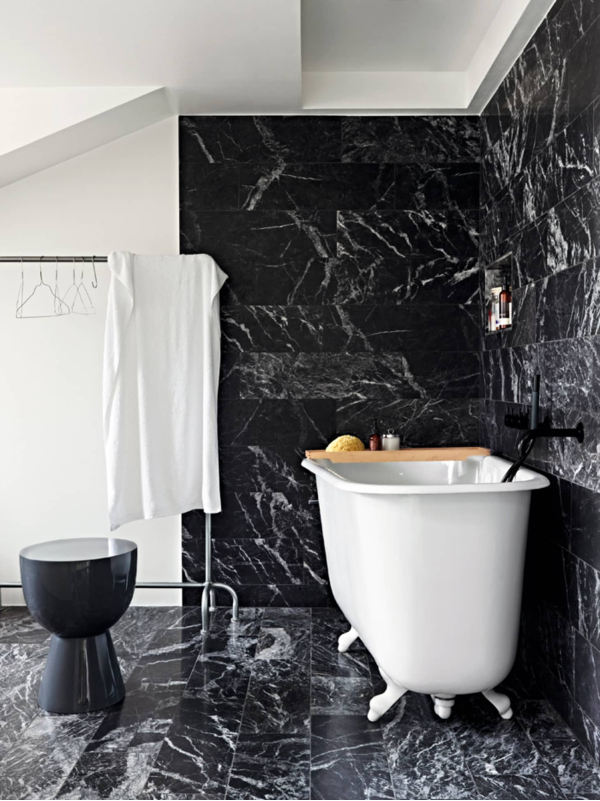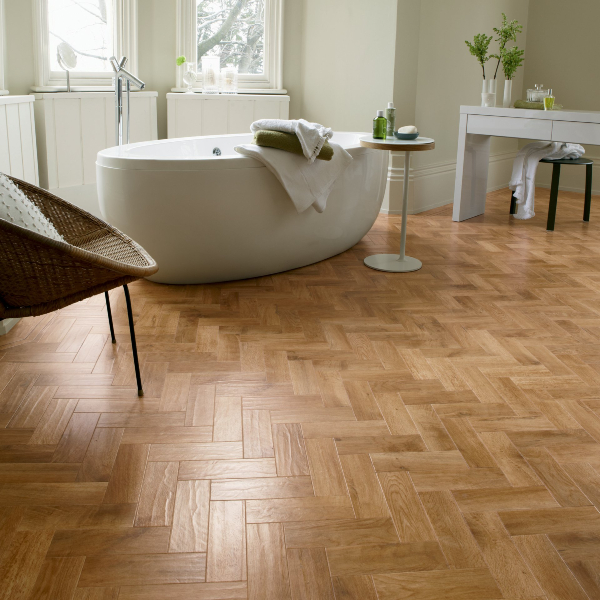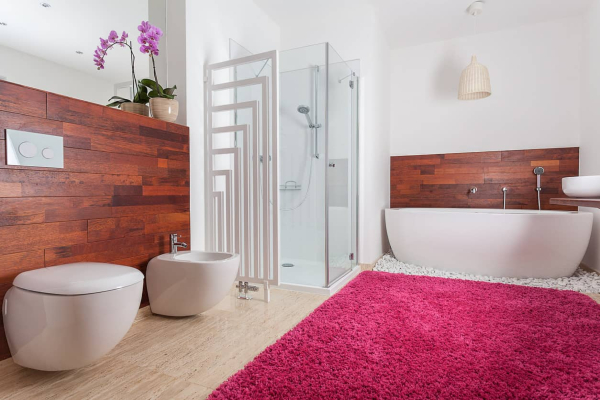Choosing the best bathroom flooring for a project to refresh or renovate the area where you get clean, is a challenge that can be tough to get right.
Before you venture out looking for the perfect bathroom flooring to pair with the fittings, here are a few aspects you should consider first:
1) Functional And Practical
The type of flooring has to complement your overall design style, while also fulfilling functionality and practical aspects such as being anti-slip, holding up well to water stains, as well as being low maintenance.
2) Choice Based on Lifestyle
Consider your lifestyle and how it might have an impact on your choice of bathroom flooring. For example, families with young children might want to go for ceramic tiles instead of wooden flooring, as this can better withstand splashes and pools of water.
3) Weather
The hot and humid weather in Malaysia (which tends to make us shower more often) certainly makes it problematic to maintain wood floors, which easily absorbs excess moisture.
Vinyl flooring, which is installed using a special glue, will give you the aesthetic look and feel of wooden floors minus the hassle, but moisture and humidity over a longer period of time could prove to be bad for the glue too.
4) Cost
Cost is a factor we can’t run away from. Our choices are usually narrowed down to what we can afford, but that doesn’t mean we are stuck with low-quality picks!
You see, the flooring industry is constantly innovating and offering quality products, at more and more competitive rates.
Another way to think about the cost of your flooring is by looking at it as an investment; make a good choice and it could potentially raise the value of your home in the future!
What are Some Bathroom Flooring Options?
The first consideration to make before setting your heart on a single option is to determine the type of material that will fulfil the functionality and practicality needs of your lifestyle, as well as your budget.
Depending on how you clean yourself up (are you the "flooder" type, or are you the "" type?), here are just a few options to take a look at:
1) Ceramic tiles
Ceramic tiles can be a popular and classic style choice for bathroom flooring. It not only gives your bathroom a clean and uniform look, but they’re also rugged and very durable.
Ceramic tiles are water resistant so you will never have to worry about water damage. It also holds up well to most scratches and stains, and the wear and tear from daily use doesn’t have much of a visual effect.
Choose a beautiful design to complement the walls and decor of your bathroom and you’ll make up for the high cost with better resale value in the future.
2) Marble Flooring
Natural stone like marble gives off an elegant and luxurious feel, which is a surefire way to improve your home’s value.
White (or black, if you’re looking to add an air of mystery!) marble is fantastic for bathrooms as it is naturally water-resistant, but it can also be vulnerable to being scratched and stained.
Marble is also easily damaged by acidic materials, like certain cleaning agents. However, individual marble tiles can be easily replaced without the need to redo the entire floor.
3) Wood Flooring
Solid hardwood flooring has a natural warmth and inviting feel to it, but doesn’t do well in areas with high moisture and humidity.
Hardwood flooring is known to expand and contract, as well as absorb water which means spills and splashes need to be kept to a minimum if you want your floors to last a good few years.
A layer of oil can be used to protect wooden floors, but it only makes it water-resistant, and maintenance needs to be carried out often to help preserve the wood.
Water absorption will result in the wood swelling and buckling, which will leave you with uneven flooring and costly maintenance, or worse — having to replace the entire flooring.
Untreated wooden flooring can attract termites resulting in permanent damage that will be expensive and time-consuming to repair, let alone replace.
4) Parquet Flooring
Similar to wooden flooring, parquet flooring in the bathroom should be made completely waterproof.
The choice of wood and how it is installed is equally important to ensure the material can withstand high moisture rates, humidity, and high foot traffic.
Tropical hardwoods, like teak, is usually a better choice, because the fibers are tightly packed together, resulting in less absorption of water.
Puddles of water on parquet flooring is a big no! Moisture could potentially penetrate the wood to the subfloor within a very short time frame, causing it to swell and bubble up.
A properly oiled surface using parquet oil helps preserve your flooring by allowing the substance to penetrate into the pores of the wood, providing a barrier of protection.
With regular maintenance comes the questions of higher costs, and the time and effort spent to maintain a parquet floor compared to a tiled floor.
5) Carpet Flooring
Unless you have a completely DRY section in your bathroom, carpeted flooring is best avoided as it can harbour bacteria and become a breeding ground for mould and mildew.
Another downside is that wet carpets get stained easily and retain moisture for longer which can leave you with a bathroom smelling musty and yucky, like a damp animal!
However, if you are able to source for a carpet specifically intended for a bathroom, it will stay odourless even if wet, allowing you to add that pop of colour and texture to spice up your daily cleansing space.
6) PVC or Vinyl Flooring
PVC or vinyl flooring is a good material to consider for your bathroom flooring because of its overall water resistance, design options, and durability.
Vinyl bathroom flooring comes in several varieties which include sheet vinyl, plank vinyl, and tile vinyl.
Sheet vinyl comes as one big solid piece and is the best option for bathrooms, compared to vinyl tiles that are individually laid out.
The lack of seams in a piece of sheet vinyl means it will be harder for water to penetrate to the subfloor and cause serious damage.
However, it is still best to avoid sheet vinyl in the shower where there is excessive moisture as small tears can lead to water seeping below to the subfloor.
Explore Your Design Style
Now that you have an idea of the type of flooring material that suits your needs, you can start thinking about bathroom flooring design options.
This is the fun part where you get to unleash your creativity and play with different designs, colours, and textures that speak to your unique style.
From wooden themed designs to contemporary concrete, the floor is your canvas to express yourself, and quite the great conversation starter!
Thinking of freshening up the look of your bathroom floor yet? Here’s a handy list of pros and cons of different bathroom floorings to help you make the right choice:
Tiles
High
High, but can help increase release value on home
Easy to care and clean, & very low maintenance
Easy to replace a single tile
Marble
High
High, but can help increase release value on home
Medium, & marble can get stained or get damaged by acidic cleaning agents
Easy to replace a single tile
Wood
Medium, with regular maintenance
High, & maintenance is also high
High cost and needs regular maintenance
Difficult to source the right type of wood to replace
Parquet
Medium, with regular maintenance
High, & maintenance is also high
High cost and needs regular maintenance
Need to source for replacement that matches current design
Carpet
Low
Low
High maintenance, not easy to clean, can harbour mould and mildew which affects health
Need to replace entire piece
PVC/Vinyl
High
Low
Easy to clean but water seeping through tears can damage the subfloor
Sheet vinyl will need to be replaced entirely
No matter what option you go with, remember that functionality and practicality are the two most important aspects to consider.
You don’t want bathroom flooring that merely looks nice. You want to make sure it is suited to your needs, is safe for people of all ages, as well as lasts a long time.
Relevant Guides:
Disclaimer: The information is provided for general information only. PropertyGuru International (Malaysia) Sdn Bhd makes no representations or warranties in relation to the information, including but not limited to any representation or warranty as to the fitness for any particular purpose of the information to the fullest extent permitted by law. While every effort has been made to ensure that the information provided in this article is accurate, reliable, and complete as of the time of writing, the information provided in this article should not be relied upon to make any financial, investment, real estate or legal decisions. Additionally, the information should not substitute advice from a trained professional who can take into account your personal facts and circumstances, and we accept no liability if you use the information to form decisions.









